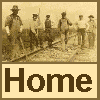
Railroads of Madison County
Anderson Young Ballet Theatre
(Corrected and updated 2/17/2006 - rph)

"Big Four" Depot - Anderson, Indiana
Historical Significance to the Community
The influx of the railroads into Anderson in 1931 brought commerce and substantial growth to the community. Because of the Depot's unique features, historic and cultural contributions, the building was given an "outstanding" rating by the Department of Natural Resources Survey of Historic Places. The Depot was once the "hub" of the community, and in 1932, it was reported that the "Big Four" had sent 8,760 passenger trains to the Depot in that year alone. in 1932, the "Big Four" employed 1,500 persons in Madison County and was the county's largest taxpayer at $133,000 per year..
The "Big Four" Depot has held significance in the community from its date of construction in 1887, through the present century, and in its present use as a ballet studio.
Birth of the "Big Four"
The stretch of railroad between Indianapolis and Union City, Indiana (now part of the CSX System) is the oldest part of what was once the "Big Four" railroad system. it was originally built under the name of the Indianapolis and Bellefontaine Railroad because it connected at Union City, Indiana with a line to Bellefontaine. Initially chartered in 1848, the Bellefontaine consolidated with the Cleveland, Columbus, Cincinnati and Indianapolis Railway, better known as the "Bee Line". The "Bee Line" consolidated with two other railroad systems (the Cincinnati, Chicago and St. Louis Railroad) and the (Chicago, indianapolis and St. Louis) in 1889 forming the Cleveland, Cincinnati, Chicago and St. Louis Railroad, popularly known as the "Big Four". As envisioned by the early builders of the Bellefontaine, this railroad was to become a link in the chain of roads that would connect St. Louis, Indianapolis, Sandusky and Cleveland, Ohio with the east.
The Bellefontaine laid the first railroad tracks in Madison County in 1850. The next year, the line was extended through Pendleton to Anderson and Chesterfield, linking these towns with Indianapolis. By January of 1853, the company celebrated the opening of the line all the way to Union City, where it joined with a finished road in Ohio at the state line, giving indiana its first link to the eastern seaboard.
The first Depot that served the "Bee Line" was built at the intersection of John Street and Madison Avenue. The building burned to the ground and was replaced by a new Depot on Jackson Street around 1870. When natural gas was discovered in 1887 in Madison County, a population increase occurred which brought more commerce to the area. It was at this time that a passenger Depot was built between Meridian and Main Streets. According to a 1919 Interstate Commerce Commission Valuation Report, the Type VII pressed brick and stone foundation passenger station was built on Meridian Street in 1887 by the Indianapolis and Bellefontaine Railroad, predecessor of the Cleveland, Cincinnati, Chicago and St. Louis Railroad (Big Four). It was constructed with rough-faced stone and brick walls covered by a hipped roof with flared eaves. Its Richardsonian Romanesque arched entrance was one of its salient features.
Railroads and the "Gas Boom"
Beginning of the Interurban
The "Big Four" Depot
In 1980, Anderson attorney, John Eisele rescued the dilapidated building and with extensive remodeling, it became the "Park Tudor" gift shop. The gift shop sold fine gifts, china and housewares. A new roof was added to the building the inside was painted and the floor was repaired. None of the interior walls were disturbed, but a display platform was added to the interior on the east end of the building. The elegant shop was closed for unknown reasons in 1982.
In 1983, Ms. Elsie Perdue purchased the building from Mr. Eisele on contract. It was Elsie's dream to open a center for the performing arts. For two years, the "Performing Arts Station" hosted competitions for artists and poets, a street fair, poetry readings and afternoon musicals. The center also offered music lessons and held art shows. The west end of the building housed a railroad museum which displayed model trains and early railroad trivia. Unfortunately, patronage alone could not sustain the costs of operating the center and it reverted back to its former owner, Mr. Eisele, in 1993.
Permanent Residence of the Anderson Young Ballet Theatre
Bibliography
- Bowman, Elder, Public Service Commission of Indiana Report,
June 21, 1940, Indianapolis, IN
- Caldemeyer, Steven, Brother Charles Lewis Henry, Senior
Research Project, Wabash College, Wabash, IN, Dec. 16, 1992
- Fish, Henry, Illustrated Anderson Indiana USA, 1915
Anderson, Reprinted Hudson Printing, Anderson, IN, 1966
- Forkner, John L., History of Madison County Indiana Vol. I,
Lewis Pub. Co., New York, 1914
- Forkner, John and Dyson, Byron, Historical Sketches of
Madison County Indiana, Published 1897 Anderson, Reprinted by
Unigraphic, Inc., Evansville, IN, 1973
- Interstate Commerce Commission Valuation Report, March 6,
1919, Revised Feb. 28, 1922
- McDonald, William S., The Union Traction Company of Indiana,
a dissertation submitted to the Graduate Studies Committee in
partial fulfillment for the degree of Doctor of Philosophy, Ball
State University, Muncie, In, Feb., 1969
- Murphy, Maurice, Ared, The Big Four Railroad in Indiana,
Indiana Magazine of History Vol. XXI, 1925 No. II and III, June
and September 1925
- Netterville, J.J., Centennial History of Madison County Indiana Vol. I, Historians Association Publishers, Anderson, IN 1925
Newspaper Articles
March 29, 1948, April 19, 1948, May 2, 1966, November 20, 1969, March 28, 1985
Anderson Sunday Herald, Anderson, IN
July 2, 1978
Return to Big Four 'Bee Line' or Return to Main Page

Last updated February 17, 2006.
This "Railroads of Madision County" page is written, maintained
and hosted by: Roger P. Hensley
madisonrails@railfan.net
Copyright 1998-2006 by Roger P. Hensley.




